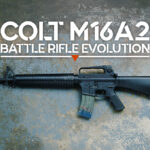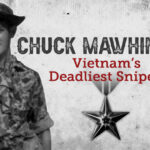

The M1 Carbine was designed and deployed during World War 2. Believe it or not, there are more M1 Carbines out there than the notorious M1 Garand (6.1 million vs. 5.4 million). But what made this popular firearm so compelling?
The U.S. Military built the M1 Carbine because they wanted a light, portable, and reliable firearm. They needed a firearm that was easier to shoot than a pistol yet had an edge in power and range. As it turned out, the M1 Carbine fits the bill perfectly, leading to high demand then and continued demand now.
Let’s start at the beginning.
M1 Carbine History

David Marshall ‘Carbine’ Williams with General Douglas MacArthur, circa 1950s. (Credit: ncdcr.gov)
This noteworthy firearm was several years in the making, with military officials finally responding to calls for a light rifle. The plan came together around 1940, when Colt Firearms discovered David “Carbine” Williams and his designs in an unlikely place: prison.
An entire book could be written about Carbine Williams (and there IS a movie about him), but the gist is this: David Williams was a moonshiner. He eventually went to prison after a shootout left a police officer dead. He denied firing with the intent of killing the officer, but that didn’t stop him from serving time.
While in prison and working in a blacksmith shop, Williams began working on the designs for the M1 Carbine. His formidable design impressed military officials, and his work would ultimately lead to a commutation of his sentence and release.
And the M1 Carbine would take shape from there.
Purpose-Built Features
The M1 Carbine is a straightforward firearm, which is one of the reasons for its popularity. Like many beloved firearms, simplicity, and reliability go hand in hand. However, just because the M1 Carbine is a purpose-built firearm doesn’t mean there aren’t some interesting features and variations.
Specs:
- Barrel length: 17.75″
- Overall length: 35.6″
- Weight empty: 5.2 lbs.
- Capacity: 15 (30 in the “M2” variation)
Here are some of the unique features of the M1 Carbine:
- The caliber: .30 Carbine. Unlike the M1 Garand, which adopted an already popular caliber, the .30 was specially made to suit this rifle. The .30 Carbine is more than capable when viewed as a large sidearm. However, if you were hoping for rifle power, you might be disappointed.
- Flip sights: Rear sight for 100 meters and 300 meters. There was a version with fully adjustable rear sights; however, the practicality of these sights on a point-and-shoot style weapon has been questionable.
- The sling slot with lubrication holder: The sling slot is a relatively unique and endearing aspect of the rifle. Within the stock of the M1 Carbine, the sling holder also served as a small reservoir for oil, ensuring that soldiers could keep their Carbines running smoothly while in the fight.
Now you know about the caliber and the features of the M1 Carbine, but what about its practical uses?
Military Use Of The M1 Carbine

The M1 Carbine is a semiautomatic gas-operated infantry rifle chambered in .30 Carbine.
The M1 Carbine was designed and created to be a step up from a standard issue sidearm. At the time, the 1911 would have been common. While a semi-automatic pistol certainly has its uses, the military recognized that, for many folks, there’s a steep learning curve to become accurate and safe with a pistol. Plus, there’s a need for continued training, and it has ammo capacity and power limitations.
While any firearm requires training, some are easier to fire proficiently than others. That’s the M1’s design purpose. It’s easy to use and reliable, making non-combatant military more effective should they need to defend themselves.
Let’s review a few practical applications of the M1 Carbine.
Here are some of the ways this firearm was deployed:
- Light gun for paratroopers: At times, the M1 Garand was cumbersome for paratroopers making jumps behind enemy lines. The M1 Carbine gave soldiers a much more portable firearm with the option of carrying a lot more ammunition.
- A “sidearm” that’s easier to shoot: The M1 Carbine can “level up” anyone in the military to become an adequate fighting force. Instead of spraying relatively low-powered handgun rounds in all directions, this gun could make anyone – cooks, drivers, or the postman – a real threat to the enemy.
- Small machine gun/urban warfare: The M1 Carbine’s handy construction and reliability made it popular in tight cities and forests, where power and distance were less important. Of course, some people tried to push this firearm further than it could go, leading to some talk about the M1 Carbine being “underpowered.” The M1 Carbine wasn’t underpowered most of the time – some users just pushed it too far.
Now, let’s look at some of the bells and whistles you could put on the M1 Carbine.
The Variations of the M1 Carbine (M2, M3, and M1A1)
Gizmos and gadgets are not a new phenomenon. Since the invention of firearms, manufacturers have designed mods, upgrades, and special editions. Here are a few of the most popular variations of this carbine.
The M2 Carbine offered a 30-round magazine, double the capacity of the previous 15-round. In addition to larger magazines, a rear site was added that allowed you to adjust for distance and windage.
The M3 Carbine featured an incredible infrared and sniper scope. Looking back at this scope, it reminds you of something from a sci-fi movie. It was big and bulky, and there weren’t that many made (around 3000).
Then we have the M1A1. The M1A1 was designed for paratroopers and featured a pistol grip and metal folding stock. The M1A1 and the standard M1 were both popular for airborne troops.
Note: What about the M1 Garand? Some people make the mistake of assuming the M1 Carbine is a smaller variation of the M1 Garand. While this is understandable (due to the similar names and relatively similar exterior design), the M1 Carbine is a separate firearm from the M1 Garand. See our guide comparing the M1 Carbine and M1 Garand.
Why This Rifle Remains Popular Today
What’s behind the major attraction of this weapon? Well, the connection people have with this gun depends on their history. However, for many, the M1 Carbine is just fun to shoot. It doesn’t kick like a mule, and – in line with the firearm’s purpose – it’s easy to learn how to handle. These features make it an excellent gun for introducing beginners to firearms of military history.
History is another reason enthusiasts love this firearm so much. The M1 played a pivotal role in World War 2. Not only that, but the story of how its manufacture (an all-hands-on-deck effort by contractor companies including IBM, General Motors, and Roc-ola), is inspiring in itself.
A .30 Caliber Legacy

With an impressive historical resume, and reliable engineering, the legacy of the M1 Carbine lives on.
The M1 Carbine proves that, like legendary Winchester lever-actions or reliable Glock pistols, good firearms will withstand the test of time. The M1 is a great place to start for those interested in historical firearms. Not only is this carbine a beautiful firearm, but it’s also great fun to shoot and won’t intimidate those who shy away from a big kick.
The U.S. Carbine, Cal. .30, M1, is nothing more than a miniature M1 rifle.” – Marine Corps Schools, Quantico, Virginia
The M1 Carbine served the United States through many wars – WW2, Korea, and Vietnam. However, the M1 has not retired yet, as it continues to serve as a reminder and symbol of the brave and ingenious men and women who fought for freedom.
If you’re eager to walk deeper into the halls of iconic military firearms, check out our guide to the M1 Garand.


